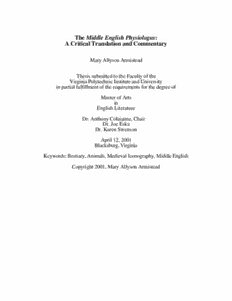
The Middle English Physiologus: A Critical Translation and Commentary PDF
127 Pages·2001·0.282 MB·English
Most books are stored in the elastic cloud where traffic is expensive. For this reason, we have a limit on daily download.
Preview The Middle English Physiologus: A Critical Translation and Commentary
Description:
The tradition of the "Physiologus" is an influential one, and informed medieval literature —not to mention medieval art and architecture—more than we know. The "Physiologus" was "an established source of Medieval sacred iconography and didactic poetry" and still continues to rank among the "books which have made a difference in the way we think" (Curley x). Thus, our understanding of the "Physiologus" and its subsequent tradition becomes increasingly important to the fields of medieval literature, humanities, and art.Considering the vast importance of the "Physiologus" tradition in the Middle Ages, one would expect to find that scholars have edited, translated, and studied all of the various versions of the "Physiologus". While most of the Latin bestiaries and versions of the "Physiologus" have been edited, translated, studied, and glossed, the "Middle English (ME) Physiologus"—the only surviving version of the "Physiologus" in Middle English—has neither been translated nor strictly studied as a literary text. In light of the "Physiologus" tradition's importance, it would seem that the only version of the "Physiologus" that was translated into Middle English would be quite significant to the study of medieval literature and to the study of English literature as a whole.Thus, in light of this discovery, the current edition attempts to spotlight this frequently overlooked text by providing an accurate translation of the "ME Physiologus," critical commentary, and historical background. Such efforts are put forth with the sincere hope that such a critical translation may win this significant version of the "Physiologus" its due critical and literary attention.
See more
The list of books you might like
Most books are stored in the elastic cloud where traffic is expensive. For this reason, we have a limit on daily download.
